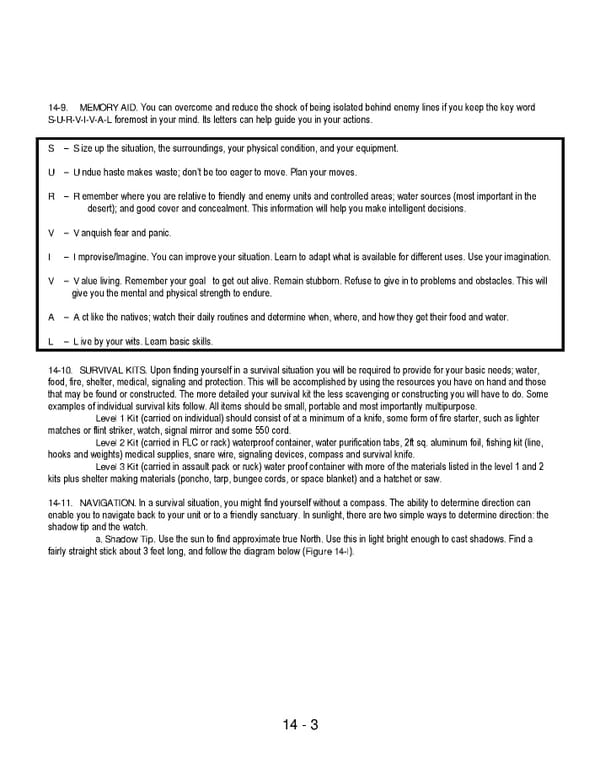14 - 3 14-9. MEMORY AID. You can overcome and reduce the shock of being isolated behind enemy lines if you keep the key word S-U-R-V-I-V-A-L foremost in your mind. Its letters can help guide you in your actions. S – S ize up the situation, the surroundings, your physical condition, and your equipment. U – U ndue haste makes waste; don’t be too eager to move. Plan your moves. R – R emember where you are relative to friendly and enemy units and controlled areas; water sources (most important in the desert); and good cover and concealment. This information will help you make intelligent decisions. V – V anquish fear and panic. I – I mprovise/Imagine. You can improve your situation. Learn to adapt what is available for different uses. Use your imagination. V – V alue living. Remember your goal to get out alive. Remain stubborn. Refuse to give in to problems and obstacles. This will give you the mental and physical strength to endure. A – A ct like the natives; watch their daily routines and determine when, where, and how they get their food and water. L – L ive by your wits. Learn basic skills. 14-10. SURVIVAL KITS. Upon finding yourself in a survival situation you will be required to provide for your basic needs; water, food, fire, shelter, medical, signaling and protection. This will be accomplished by using the resources you have on hand and those that may be found or constructed. The more detailed your survival kit the less scavenging or constructing you will have to do. Some examples of individual survival kits follow. All items should be small, portable and most importantly multipurpose. Level 1 Kit (carried on individual) should consist of at a minimum of a knife, some form of fire starter, such as lighter matches or flint striker, watch, signal mirror and some 550 cord. Level 2 Kit (carried in FLC or rack) waterproof container, water purification tabs, 2ft sq. aluminum foil, fishing kit (line, hooks and weights) medical supplies, snare wire, signaling devices, compass and survival knife. Level 3 Kit (carried in assault pack or ruck) water proof container with more of the materials listed in the level 1 and 2 kits plus shelter making materials (poncho, tarp, bungee cords, or space blanket) and a hatchet or saw. 14-11. NAVIGATION. In a survival situation, you might find yourself without a compass. The ability to determine direction can enable you to navigate back to your unit or to a friendly sanctuary. In sunlight, there are two simple ways to determine direction: the shadow tip and the watch. a. Shadow Tip. Use the sun to find approximate true North. Use this in light bright enough to cast shadows. Find a fairly straight stick about 3 feet long, and follow the diagram below (Figure 14-l).
 Ranger Handbook Page 250 Page 252
Ranger Handbook Page 250 Page 252